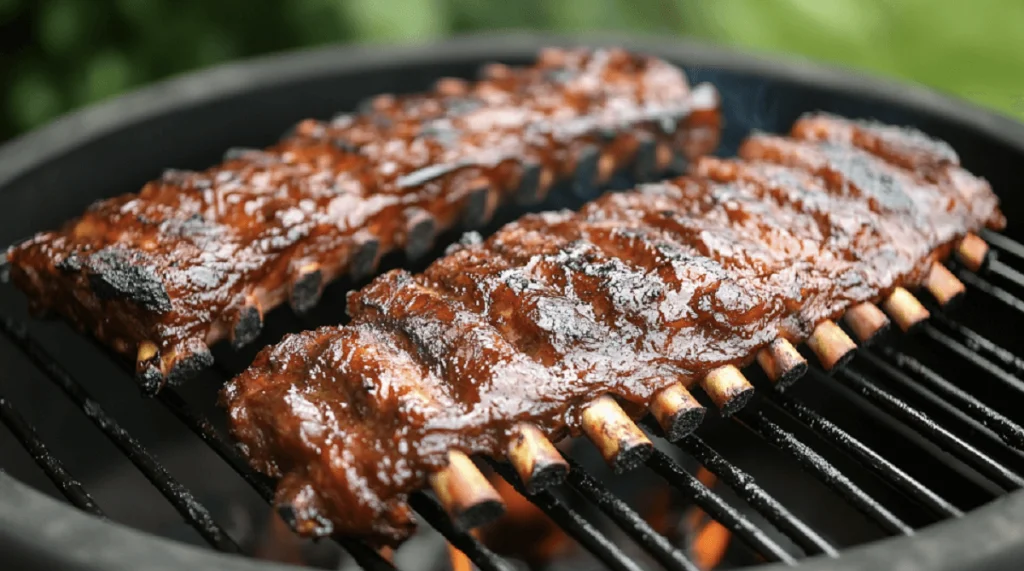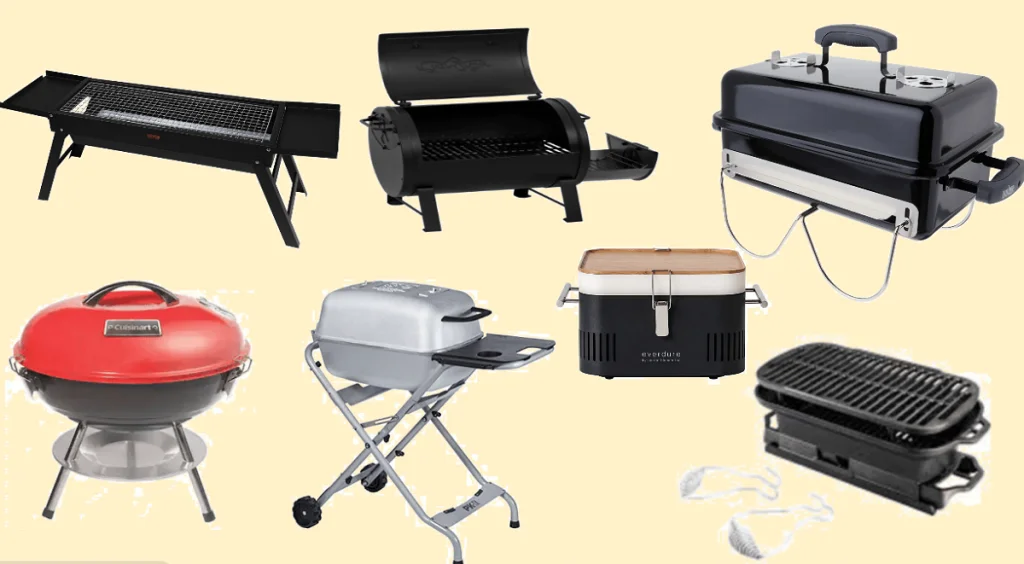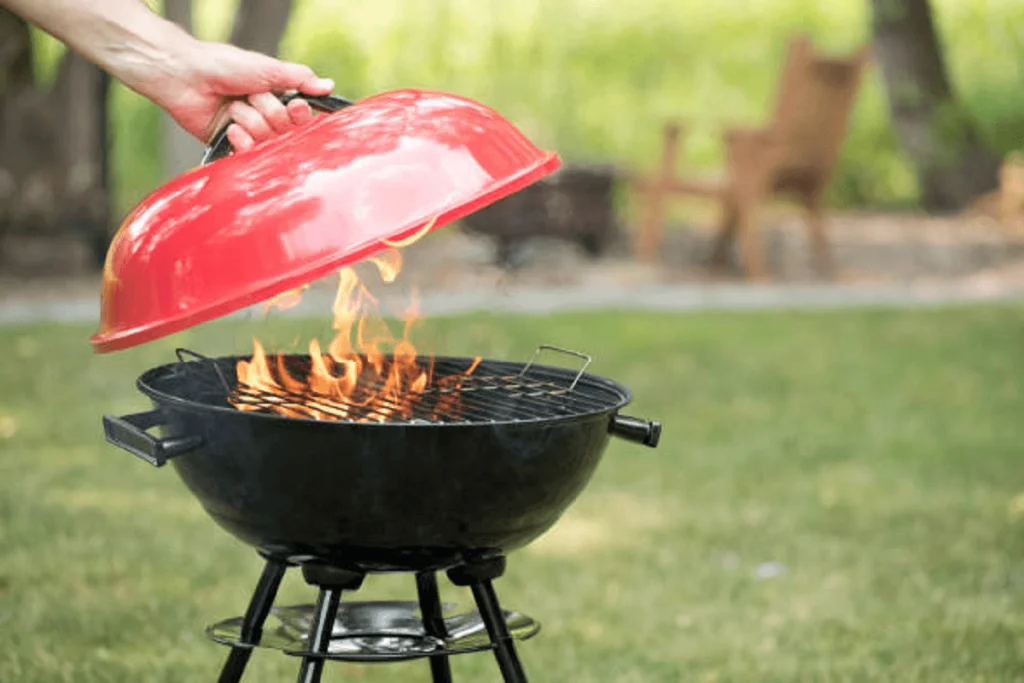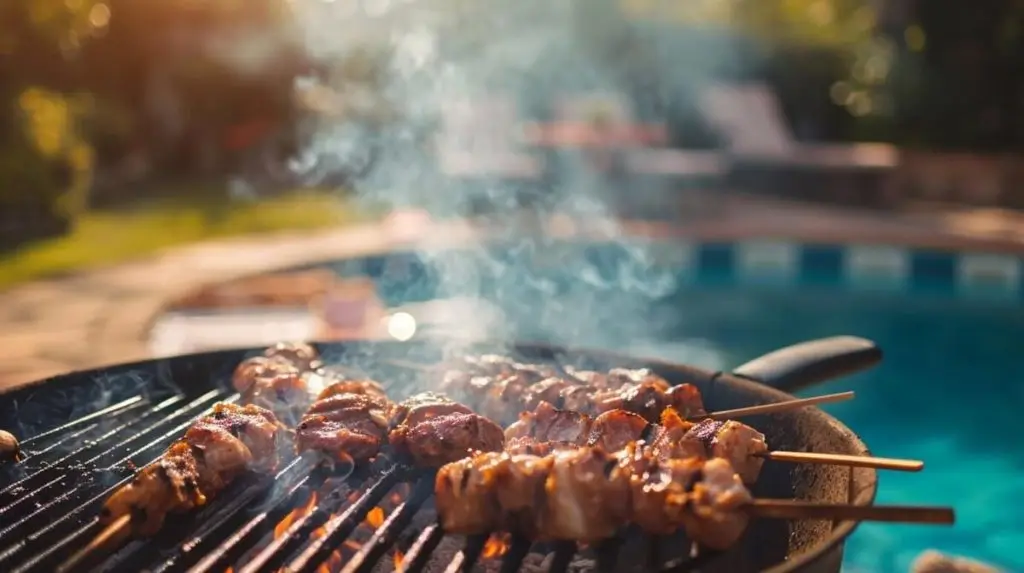Baby back ribs, spare ribs, short ribs… everyone dreams of biting into tender, juicy cuts of meat infused with several distinct smoky flavors.
Ribs have remained a timeless dish for centuries because there are several ways to cook them, including roasting, frying, boiling, or grilling.
However, if you’re looking for that unique smoky flavor synonymous with a summer cookout or a delicious dinner spread, charcoal grilling is the best way to go.
For the best results, we recommend using the VEVOR charcoal grill, which provides the perfect balance of heat and flavor infusion. It is equipped with several features designed to make grilling a breeze. From precise heat control to removable ash catchers and wheels for easy mobility, the VEVOR charcoal grill remains a top choice for grilling the most flavorful ribs.
Read on to learn how to cook ribs on a charcoal grill to achieve the perfect smoky taste everyone yearns for.
Table of contents
Why Choose a Charcoal Grill for Ribs?
You may ask, why not propane grills or electric grills?
Before we show you how to cook ribs on a charcoal grill, let’s discuss why using a charcoal grill is a must.
Well, as mentioned, a charcoal grill provides the perfect environment that produces the smokiness often found in grilled ribs. If you use a gas or electric grill for cooking your ribs, you’ll end up with a subtle flavor and an enhanced taste of whatever spices and herbs you use while cooking.
On the other hand, using a charcoal grill will give you a smoky flavor profile that no spice or herb can produce. To add to that, ribs are tough cuts of meat that need to be tenderized and cooked slowly before spices can permeate through them. A charcoal grill uses slow-burning coals that allow ribs to cook slowly and properly, just like they should.
The VEVOR charcoal grill makes this easily achievable because it provides excellent temperature control that ensures your ribs are cooked evenly. It is also durable enough to provide a steady supply of heat over a long period without compromising the taste of your ribs.
Essential Tools and Ingredients for Cooking Ribs

Learning how to cook ribs on a charcoal grill requires a thorough understanding of all the essential tools and ingredients involved in the process.
You’ll need tools like:
- Charcoal Grill (The VEVOR charcoal grill comes highly recommended for this)
- Charcoal
- Tongs
- Basting Brush
- Fire Extinguisher
You’ll also need ingredients like:
- Ribs
- Brown sugar
- Chile sauce
- Ketchup
- Soy sauce
- Worcestershire sauce
- Rum
- Garlic
- Mustard
- Black pepper
- Cooking spray
Recommended For Your Project
Understanding Different Cuts of Ribs
Different cuts of ribs have different tastes and require different cooking times and methods. As such, it is essential to understand the difference between baby back ribs, spare ribs, and St. Louis-style ribs.
- Baby Back Ribs: Baby back ribs do not come from baby pigs, as you may think. Instead, they come from fully grown pigs, but they are usually smaller than other ribs because they’re found in the upper part of the rib cage. They cook faster than St. Louis-style ribs and spare ribs.
- St. Louis-Style Ribs: These ribs come from the belly of a pig. They are typically flat and have tough cartilage around them. They also tend to have a lot of extra fat, which adds to their flavor and taste.
- Spare Ribs: Like St. Louis ribs, spare ribs also come from the belly of the pig. They’re larger and meatier than baby back ribs, and you’ll have to cook them slowly on low heat to achieve the best flavor.
Here’s a pro tip to keep in mind when choosing ribs to cook: While selecting ribs, look for cuts of meat that have a good amount of fat marbling, but be careful not to choose one that has too much fat.
Preparing the Ribs: Trimming and Seasoning
As you learn how to cook ribs in a charcoal grill, you must also learn how to prepare the ribs for cooking. This involves trimming and seasoning.
Trimming is an essential part of the preparation process because it helps you achieve evenly cooked ribs and also improves the overall presentation of the ribs when they are grilled.
Trimming
To trim ribs, you’ll need:
- Cutting board
- Filet knife or chef’s knife
- Paper towels
- Butter knife
Here are the steps involved in trimming ribs before grilling:
- Remove the Breastbone: Also known as the sternum, this hangs below the curve of the ribs. To remove it, position the ribs upwards and use your fingers to locate a curved piece of meat, which is attached to the breastbone at the bottom. Then, place the blade of the knife under the rib bones and run it carefully across the curve.
- Remove the Flap: Next, you have to remove the flap, which is an oddly shaped piece of fat found after the last rib. To remove it, simply use your filet knife to cut off the excess meat after the last rib.
- Remove the Skirt: Once the flap is off, you can then remove the skirt. Keep the ribs facing upwards, and find and trim the excess pieces of fat that run along the membrane line.
- Remove the Membrane: Finally, remove the membrane itself, which is the long silver of white film that runs across the back of the ribs. Use a paper towel to help you get a good grip on the membrane, firmly pull back and use a butter knife to separate it from the rack of ribs.
Seasoning
The best way to season ribs before grilling them is to make a seasoning mix and marinate them overnight for optimum flavor.

For a dry rib rub, mix the following seasoning powders in a bowl:
- Brown sugar (¼ teaspoon)
- Kosher salt (2 teaspoons)
- Black pepper (2 teaspoons)
- Smoked paprika (2 teaspoons)
- Garlic powder (1 teaspoon)
- Onion powder (1 teaspoon)
- Ground mustard (1 teaspoon)
- Cinnamon powder (½ teaspoon)
- Celery salt (½ teaspoon)
- Cayenne pepper (¼ teaspoon)
Ensure there are no clumps, and store it in an airtight container if you have any leftovers.
Setting Up Your Charcoal Grill for Ribs
If you want to achieve the perfect smoky ribs, it’s not just enough to use a good seasoning blend. You also have to know how to set up your grill, the type of coal to use, and the proper coal placement to adopt.
The Importance of Proper Charcoal Placement
When it comes to charcoal grilling, you can either use direct or indirect heat.
- Direct Heat: Using direct heat involves cooking the ribs directly over hot coals. The coals should be spread evenly across the entire charcoal grate, as this will provide an even heat supply. With this method, the meat is cooked either through radiant heat or conductive heat.
- Indirect Heat: On the other hand, indirect heat is used when you place the ribs away from the coals and close the lid of the grill. Doing this makes the ribs cook through convection heat, which is similar to how an oven works.
Type of Coal to Use
The type of coal you use also greatly influences the outcome of your grilled ribs.
- Briquettes: For grilling, briquettes are the best choice. They may take longer to light when compared to lump coal, but they provide more even flames that burn slowly– the perfect setup for delicious ribs.
- Lump Charcoal: This type of coal is made of wood and has no additives. It burns hotter and faster than briquettes, so you will have to exercise caution when using it. Otherwise, you’ll risk charring or burning the ribs.
Preheating the Grill: Achieving the Perfect Temperature
Think of grilling as an art. You can play around with various spices and herbs to achieve your desired flavor. However, you also have to be extra careful to use the perfect temperature while cooking. Too hot, and you’ll end up with charred ribs. Too low, and you’ll end up with chewy and unevenly cooked ribs.
- To preheat the grill, start by using a chimney starter to light the charcoal.
- Let it burn until the briquettes become white and ashy
- Cover the lid of the grill and leave to preheat for about 15 minutes. Once the temperature is about 275°F, you’re good to go
- You can use the two-zone direct fire method by piling a heap of coal on one side of the grill and spreading scattered coals on the other side
- Alternatively, you can also use the two-zone indirect fire method by arranging a heap of coal on one side of the grill and leaving the other side empty.
- To maintain consistent heat throughout the cooking process, keep the grill’s vents closed, as this helps to provide a consistent flow of air to keep the coals burning steadily. Ensure the temperature of the grill hovers between 250° to 300°F for the best results
Step-by-Step Guide: How to Cook Ribs in a Charcoal Grill
So far, we’ve done loads of food prep. Now, let’s get to the juicy part– a step-by-step process of how to cook ribs in a charcoal grill.
Preparing the Grill: Adding the Ribs to the Charcoal Grill
Here’s how to add the ribs to the charcoal grill like a pro:
- Take out your pre-seasoned ribs and set them aside. (You can add a layer of mustard to help the seasoning stick more while grilling)
- Place the ribs on a sheet tray with the bones facing upwards
- Add chicken stock and vinegar to the tray and wrap tightly in aluminum foil
- Place in the charcoal grill
- Place a drip pan beneath the ribs, as this will catch fat drippings, prevent flare-ups, and help maintain the overall juiciness of the ribs
Cooking the Ribs: Low and Slow Method
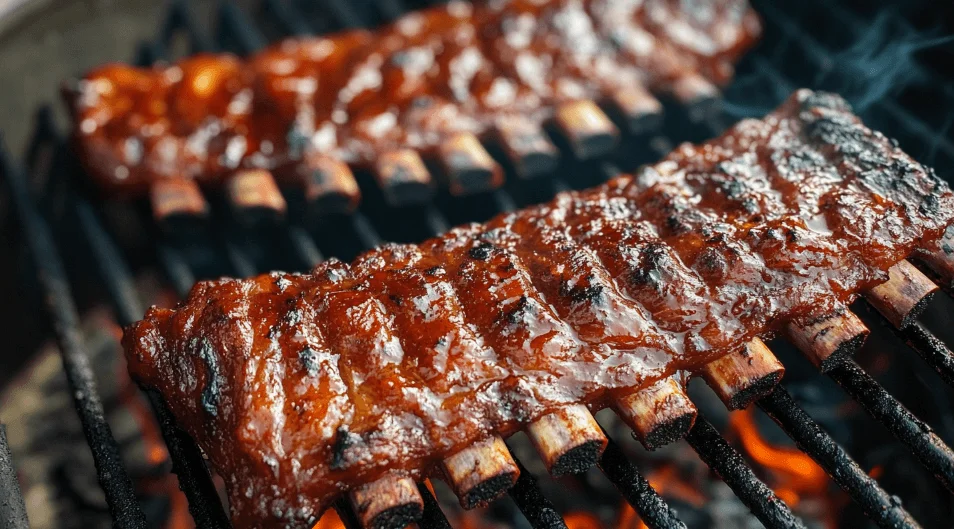
The trick to using the slow and low method is to keep it low and slow for most of the cooking by putting the ribs in the indirect zone. After that, finish off by putting them in a direct heat zone to get the perfect char.
Here are the steps to follow:
- Place the grate at least 4 inches above the coal
- Use cooking spray to grease the grate
- Place the ribs on the grate and close the top vent halfway
- Let the ribs cook with the meaty side up and the bony side down
- Let them cook for about 2 hours, 30 minutes to 3 hours
- When the ribs are done, take them out of the foil and finish them off over direct heat by placing them in the direct heat zone of the grill.
Flipping and Basting: Enhancing Flavor
As you grill the ribs, it is essential to flip and bast now and then to enhance their flavor. Here’s how to do this:
- Rotate the rack of ribs every 30 minutes for even distribution of heat
- Flip the ribs every hour to prevent charring
Checking for Doneness: When Are Ribs Ready?
Don’t be in a hurry to get your ribs off the grill. You need to check if they are cooked all the way through. Here are some ways to check for this:
- The meat should easily pull back from the bones
- A toothpick should easily slide into the meaty part of the ribs without resistance
- For an accurate measure, insert a meat thermometer into the thickest part of the ribs. It should read between 190°F and 206°F
The Finishing Touch: Adding BBQ Sauce
Finally, the only way to get that finger-licking goodness is by adding BBQ sauce. Here are some tips to keep in mind in this crucial stage:
When and How to Apply BBQ Sauce
In the last hour or thirty minutes of grilling, brush the ribs with your favorite barbecue sauce before placing them in the direct heat zone. This basting technique will allow the sauce to caramelize, thereby producing extra crispy edges with just the right amount of tenderness on the inside.
Resting the Ribs: Why It Matters
Don’t make the mistake of taking the ribs straight from the grill to your plate. You need to let it rest for about 10 to 15 minutes. This will allow the juices and flavors to redistribute throughout the meat, producing a more flavorful taste and preventing dryness.
Serving and Enjoying Your Grilled Ribs

After hours of grilling, your ribs are finally ready to eat. When slicing, ensure you slice between the bones to create perfect cuts of meat. Some of the best sides that go with ribs include mashed potatoes, baked beans, coleslaw, and corn on the cob.
For a refreshing taste, serve with semi-sweet red wine, chilled ice tea, or cold beer, as these enhance the smokiness of the ribs.
Common Issues and How to Avoid Them
Here are some common issues to avoid when practicing how to cook ribs on a charcoal grill.
Overcooked or Undercooked Ribs
If you take the ribs out too early, you’ll end up with undercooked ribs. To fix this, take the ribs back to the grill and extend the cooking time while keeping the temperature constant.
On the other hand, if you cook the ribs for too long, they will end up dry and chewy. To fix this, wrap the ribs in aluminum foil. Coat the ribs in a mixture of BBQ sauce and apple cider vinegar and place them back on the grill to rehydrate them.
Flare-Ups and Temperature Control
While grilling, you may experience flare-ups, which can burn the ribs or result in unevenly cooked meat. To avoid this, use a pan to catch fat dripping, which can contribute to flare-ups. You can also avoid flare-ups by using the grill’s air vents to control the airflow and make sure the temperature remains steady at all times.
Conclusion
If you’re looking for the ultimate guide to learning how to cook ribs in a charcoal grill, this post has all the expert information you need to know. Here’s a recap of the steps we discussed:
- Prepare the ribs by removing the breastbone and trimming the flap, skirt, and membrane
- Season the ribs by mixing a dry dub of spices and marinating them overnight
- Set up your charcoal grill by arranging the coals to provide direct and indirect heat zones
- Preheat the grill to about 275°F
- Place the ribs in aluminum foil and let it cook for 2 hours and 30 minutes, remembering to rotate the rack of ribs every 30 minutes
- Flip and bast every 30 minutes or one hour
- Use a thermometer to check for doneness. It should read between 190°F and 206°F and the meat should easily fall off the bone
- Finally, add BBQ sauce in the last hour of grilling and let the ribs rest before serving and dishing
Remember that the type of grill you use will affect the outcome of the ribs. Opt for a high-quality grill like the VEVOR kettle charcoal grill. It has a large 22-inch grate that can accommodate ribs of all sizes. It is also equipped with a removable ash catcher to provide easy clean-up during and after grilling.
Are you looking for the perfect grill for cooking the juiciest, smokiest ribs? Try the VEVOR charcoal grill today, the secret tool for making delicious ribs anytime, anywhere!

